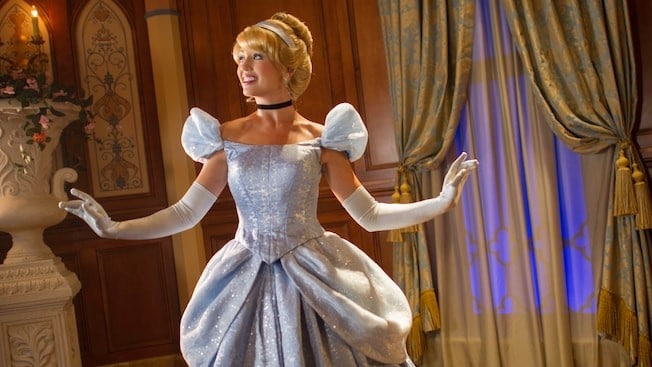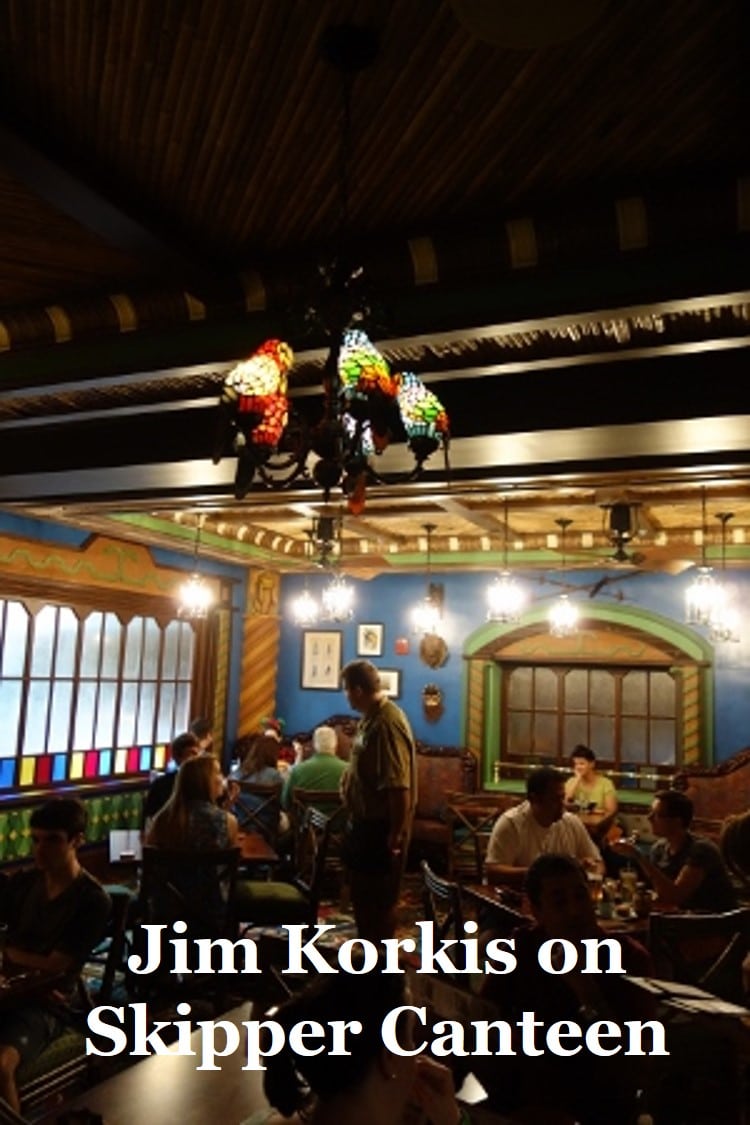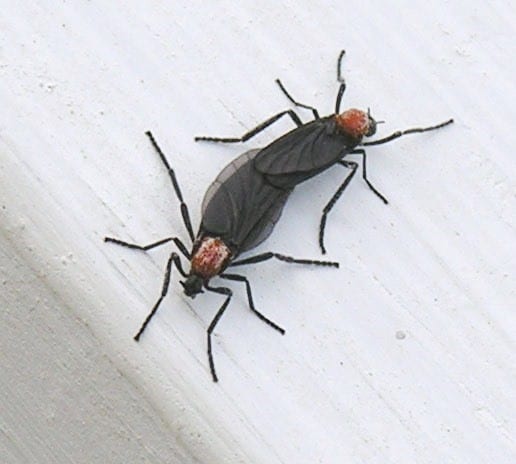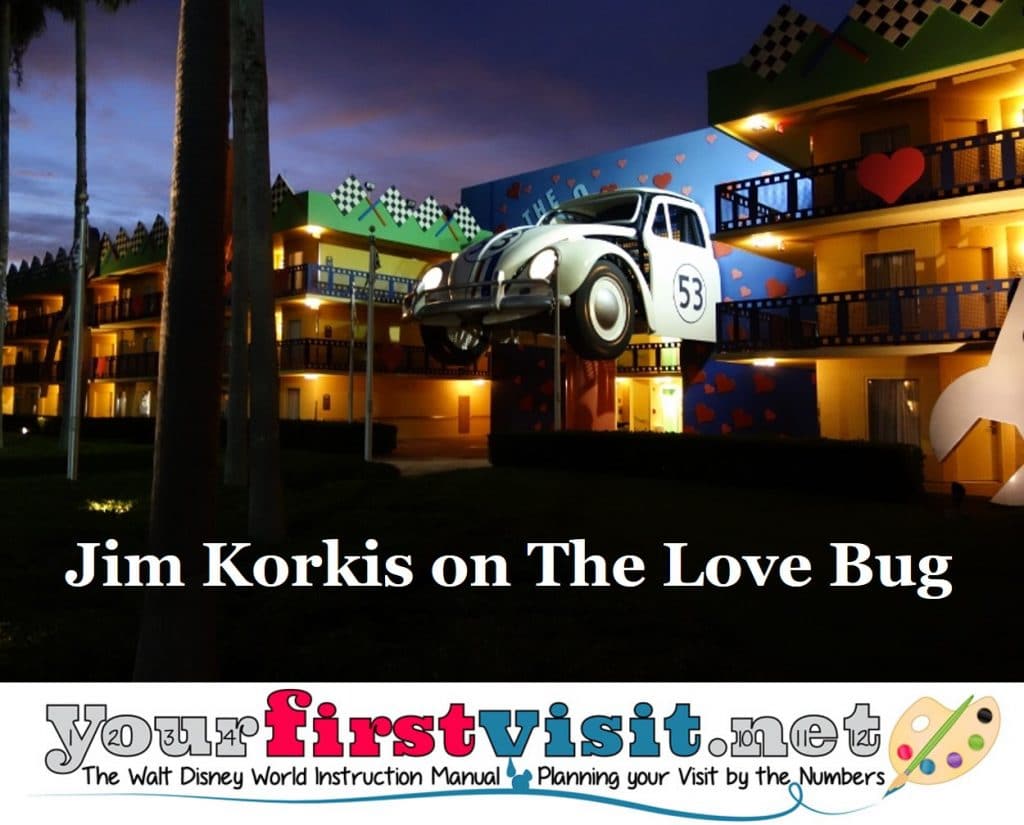Category — A Friday Visit with Jim Korkis
A Friday Visit with Jim Korkis: Princess Fairytale Hall
Welcome back to Fridays with Jim Korkis! Jim, the dean of Disney historians, writes about Walt Disney World history every Friday on yourfirstvisit.net.
PRINCESS FAIRYTALE HALL
By Jim Korkis
On June 2, 2012, Walt Disney World closed the Snow White’s Scary Adventures attraction. The Disney Princesses had been at the Town Square Theater on Main Street U.S.A. awaiting an expansion of Fantasyland that was originally going to feature individual areas for each of them. Those plans changed and instead the Princess Fairytale Hall opened in the ride’s location on September 18, 2013.
“Princess Fairytale Hall is an annex to Cinderella Castle where our royal guests, our park guests, will come to meet a visiting princess,” Imagineer Jason Grandt, who was the creative art designer of the space, told me in 2013. “It is done in the same regal style as other additions to the castle so that it is a wonderfully detailed architectural environment fitting of Disney royalty.”
Guests pass through lush purple and gold exterior trimmings with stained glass windows featuring animal characters from the classic Disney animated movie Cinderella (1950) like the mice Jacques and Gus-Gus as well as shields adorned with each princess’s symbol that hang around the marquee. The outdoor light fixtures are in the shape of crowns.
Entering an elegant corridor filled with tapestries and themed lighting leads to an airy, high-ceilinged Royal Gallery with nearly full-sized portraits of Aurora, Tiana, Rapunzel, Mulan, Jasmine, and Snow White. This room also houses Cinderella’s glass slipper illuminated in a special case.
“The space is really opulent and filled with ornate chandeliers and several framed custom princess portraits that are stunning. They were painted by talented Disney artists who diligently labored to capture the atmosphere, design and story moments of the films.
“When they came into the office full size rather than just a computer sized image, we all just gasped; they were so lush and full of detail. Our portraits are to show that there are Disney princesses all over the world but the hall is primarily devoted to Cinderella.
“From there, you will be dispatched to a magnificent receiving room to meet with a princess and get photos, autographs and time to talk with her,” stated Grandt.
The rooms with luxurious carpets and drapes contain open storybooks. Snow White’s storybook is permanently placed as a tribute to the former ride and to the first Disney princess. The rooms also include props from the films like the king’s bookends in the Cinderella room.
“The team kept playing the films while we were working and the more you watch them, the more you see subtle things that you can include.
“For our Disney guests, we know that next to meeting Mickey Mouse, the Disney princesses are their greatest wish for us to make those fantasy worlds become a reality. Our Disney princesses are truly the heart of Fantasyland and now they have this very special location to interact with our guests.
“Part of the fun will be not knowing until that day which princess might be visiting with Cinderella or Rapunzel. Ariel and Belle have their own locations so won’t be here. Our guests want opportunities to meet the princesses and this royal encounter location will help satisfy those wishes.”
According to the Imagineering storyline, Princess Fairytale Hall is a gift from the King to Cinderella, and acts as a place where she can meet with visiting royalty and along with those other princesses can greet the subjects of Fantasyland.
Imagineer Pam Rawlins, assistant producer, said, “Guests are immersed into this majestic world of the princesses. It is all very elegant, with dark wood panelings and elegant finishes, with a bit of a gothic motif, so you really feel like you’re in the castle. You will be a royal subject meeting your princess.”
* * * * *
Thanks, Jim! As it turns out, the “second” princess in each meet has usually had an extended run, rather than being a daily surprise.
And come back next Friday for more from Jim Korkis!
In the meantime, check out his books, including his latest, Secret Stories of Disneyland, and his Secret Stories of Walt Disney World: Things You Never You Never Knew, which reprints much material first written for this site, all published by Theme Park Press.
Follow yourfirstvisit.net on Facebook or Twitter or Pinterest!!
September 8, 2017 No Comments
A Friday Visit with Jim Korkis: Dole Whips!
Welcome back to Fridays with Jim Korkis! Jim, the dean of Disney historians, writes about Walt Disney World history every Friday on yourfirstvisit.net.
DOLE WHIPS
By Jim Korkis
A cult following for a soft-serve frozen dessert created by the Dole Food Company known as Dole Whip has created such a frenzy in Disney theme park fans that many suspect that the treat is only available at Disney. It is not.
Of course, it has been served for decades at the Dole Plantation three miles north of Wahiawa, Hawaii, but in recent years, thanks to the ease in creating it, a variety of popular venues now offer it, from sporting events to zoos to state fairs and other amusement venues. Outside of Disney, vendors are strongly encouraged to use the term Dole Soft Serve instead.
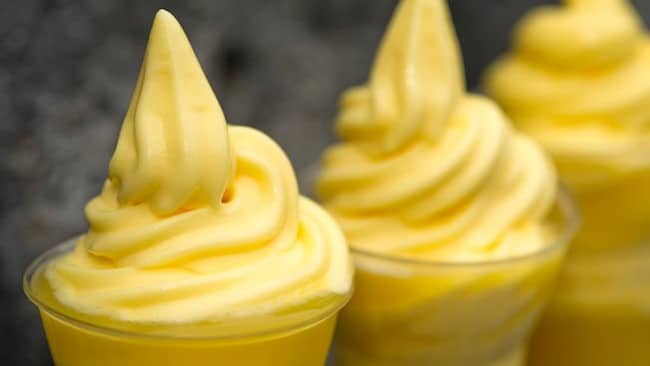
(c) Disney
“Disney has literally created Dole Whip devotees,” stated Jamie Schwartz of Kent Precision Foods Group that licenses the product. “Disney built the brand.”
When Walt Disney’s Enchanted Tiki Room opened in June 1963, it was sponsored by United Airlines, promoting its flights to Hawaii. In 1976, the Dole Food Company took over sponsorship and opened up a food and beverage stand at the entrance to the attraction called the Tiki Bar.
Disneyland’s Concept Manager of Food Operations Karlos Siqueiros, who has worked at Disneyland for over thirty years, recalled that in the beginning the little stand only sold pineapple juice and pineapple spears: “Pineapple juice had always been served at the tiki stand, but we didn’t have anything to add to it literally until the Dole Whip came in.”
The soft-serve pineapple dessert can also be purchased as a “float” with pineapple juice or as a swirl of pineapple and vanilla. While most Disney fans associate the term “Dole Whip” with pineapple soft serve, it also comes in several other flavors like orange, strawberry, lemon, raspberry and mango.
In 1997, Kent Precision Foods Group in St. Louis, Missouri began to license the Dole Whip product. While it used to contain a dairy derivative, in 2013 the formula was changed and it became certified as vegan and gluten free. They sell the Dole Whip Mix which is a dry powder online. To make it just like at Disney, all that needs to happen is to add water and pour it into a home soft serve ice cream machine.
It is estimated that park guests at Disneyland and Walt Disney World consume 1.4 million Dole Whips each year. (Disneyland consumes a minimum of 600,000). It is not served at any of the other Disney theme parks worldwide. At the Aulani Resort in Hawaii, it is offered at the Lava Shack.
At WDW, it can be found at Aloha Isle, located outside of the Enchanted Tiki Room in Adventureland, and at Pineapple Lanai just outside the back of the Great Ceremonial House at the Polynesian Village Resort.
Starting in 2013, the Pineapple Promenade Booth at the Flower and Garden Festival sold Dole Whip where guests could order it with Siesta Key Spice Rum. Subsequent years had the option for including Coconut Rum and Sammy’s Beach Bar Red Head Macadamia Nut-flavored Rum. An alcoholic version with dark rum or coconut rum can also be purchased at Tamu Tamu restaurant in Disney’s Animal Kingdom.
Kent Precision Foods explains it as such: “Dole Soft Serve Mix is a lactose-free dry mix that is reconstituted with tap water and frozen down in a soft serve machine. Marketed under the popular Dole brand name, this unique product delivers an intense, natural pineapple fruit flavor, yet is fat free and cholesterol free.
“Although the Dole Food Company originally created the Dole Whip soft serve mix, they licensed the brand to Kent Precision Foods Group who now has an exclusive agreement.”
* * * * *
Thanks, Jim! And come back next Friday for more from Jim Korkis!
In the meantime, check out his books, including his latest, Secret Stories of Disneyland, and his Secret Stories of Walt Disney World: Things You Never You Never Knew, which reprints much material first written for this site, all published by Theme Park Press.
Follow yourfirstvisit.net on Facebook or Twitter or Pinterest!!
September 1, 2017 No Comments
A Friday Visit with Jim Korkis: Morocco in Epcot’s World Showcase
Welcome back to Fridays with Jim Korkis! Jim, the dean of Disney historians and author of Jim’s Gems in The easy Guide, writes about Walt Disney World history every Friday on yourfirstvisit.net.
MOROCCO
By Jim Korkis
Morocco is the only World Showcase pavilion that is sponsored entirely by its government rather than by various businesses operating in that country. It opened September 7, 1984. The pavilion was inspired by the cities of Casablanca, Marrakesh, Rabat, and Fez.
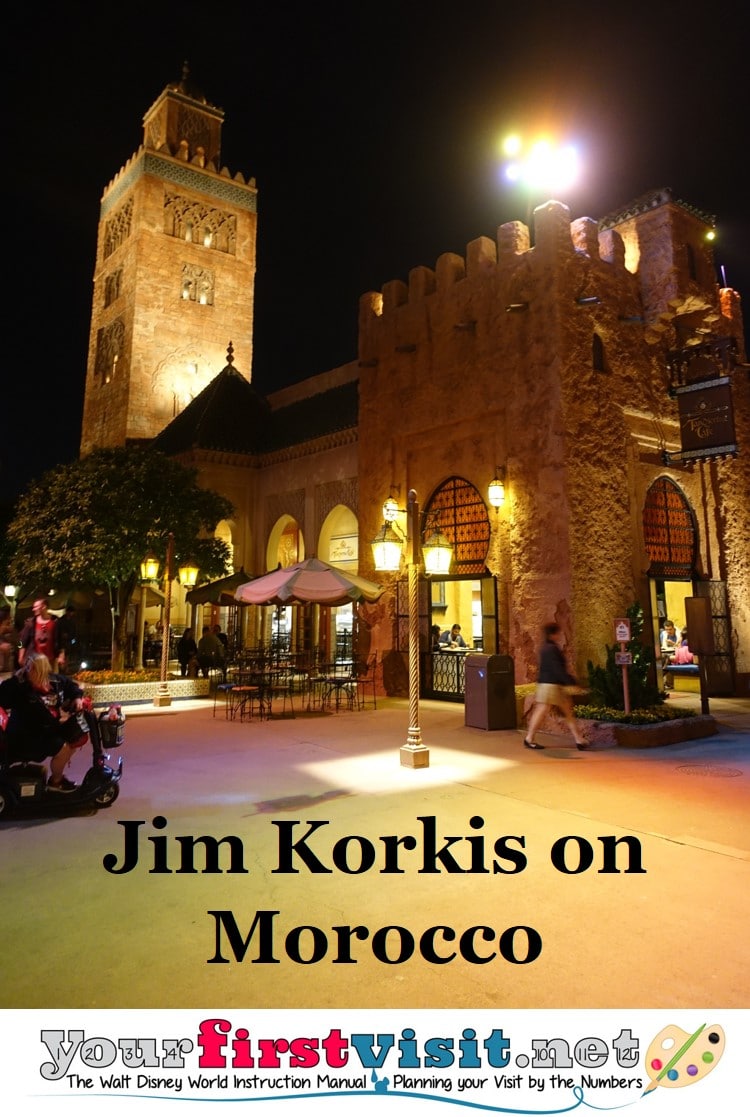
Although the overall design of the pavilion was done by Imagineering in consultation with Morocco, the actual artwork and decorations were done by these artisans that included eight plaster craftsmen, eleven tile craftsmen and two wood craftsmen. They worked for approximately six months doing the construction.
Nine tons of handmade, hand-cut tiles were used, the same kind that had been used to decorate palaces of past kings of Morocco. The designs consist of different combinations of geometric patterns. Islamic law forbids the depiction in artwork of any living thing like plants, animals or humans. It would be considered an affront against Allah, the only one who can create life.
Morocco’s King Mohammed Ben Abdellah was the first world leader to send President George Washington in 1777 a letter recognizing the United States as an independent sovereign country. A copy of that letter and President Washington’s reply is on display in the lobby of the Restaurant Marrakesh which is built to look like a typical Southern Moroccan fortress. The interior is designed after several different palaces.
Outside to the left side, high on the wall, the Dar al-Magana from the city of Fez is a unique water clock where people were able to tell the hour using the twelve windows and platforms carrying brass bowls.
Bab Boujouloud is a replica of the entrance gate of the same name located in the City of Fez. The center of the gate is large to accommodate large groups of people and traffic like camels loaded with goods. At night, the center would be blocked and those entering the city would have to enter through the smaller arches on the side and pass a guard.
It transitions guests from the Nouvelle Ville (new city) to the Medina (older city) where the Souk (marketplace) is located.
The Nejarine Fountain is a replica of a fountain located in the Medina of Fez and this is an excellent example of the tile work of King Hassan’s artisans. The word Nejarine translates to “carpenters”.
The Koutoubia Minaret at the front of the pavilion is a prayer tower beside a mosque that exists in Marrakesh. The Chellah Minaret at the back of the pavilion is located near the capital city of Rabat. A prayer caller (Muezzin) would ascend to the top and call citizens to prayer.
Fez House is a representation of an upper middle class family where all generations including any extended family would live in one house. Built in the Moorish style of architecture, rooms are like apartments and would surround a central open air courtyard. To add authenticity, the Imagineers have recorded family conversations that periodically engage on the second level.
The exterior does not seem appealing because of the traditional belief that beauty is on the inside as well as the fact that the harsh weather in the country is damaging to any exterior building. It is referred to as “architecture of the veil”.
* * * * *
Thanks, Jim! And come back next Friday for more from Jim Korkis!
In the meantime, check out his books, including his latest, Secret Stories of Disneyland, his Secret Stories of Walt Disney World: Things You Never You Never Knew, which reprints much material first written for this site, and his contributions to The easy Guide to Your Walt Disney World Visit, all published by Theme Park Press.
Follow yourfirstvisit.net on Facebook or Twitter or Pinterest!!
August 25, 2017 No Comments
A Friday Visit with Jim Korkis: Skipper Canteen
Welcome back to Fridays with Jim Korkis! Jim, the dean of Disney historians and author of Jim’s Gems in The easy Guide, writes about Walt Disney World history every Friday on yourfirstvisit.net.
SKIPPER CANTEEN
By Jim Korkis
One of the gags in the Jungle Cruise attraction at Disneyland for decades was guides pointing out that the name of the dramatic waterfall that the boat narrowly misses is Schweitzer Falls named after…Dr. Albert Falls, rather than the expected Dr. Albert Schweitzer, noted for his humanitarian work in Africa.
One of the newest Magic Kingdom restaurants is named the Jungle Navigation Company Ltd. Skipper Canteen. It is operated by Alberta Falls, the granddaughter of the fictitious Dr. Albert Falls. This 222-seat restaurant is located in the former Adventureland Veranda area across from the Swiss Family Treehouse and is home to “World Famous Jungle Cuisine”. It opened December 16, 2015.
The Jungle Navigation Co. Ltd. which operates the Jungle Cruise boats was started by Dr. Falls on April 8, 1911. His granddaughter Alberta, who is the third generation owner, has repurposed the company’s tropical headquarters into a restaurant in order to generate additional revenue from the hungry cruise passengers.
Dr. Falls had a son who married a woman from India and they had a daughter who they named Alberta in honor of her grandfather. When she was eight years old, she was sent to live with him and learn the business. The company was originally a tropical river cargo shipping venture (“and logistics services”) but as business declined Alberta opened up sight-seeing cruises for passengers. A banner states that the inaugural cruise was October 1, 1931.
The restaurant includes three dining rooms. The Crew’s Mess Hall (which servers point out is not actually messy at all) is the largest one, and includes wall hangings of photos, documents, native musical instruments, and other expedition mementos gathered by the skippers on their travels.
The Jungle Room, which was the family parlor, is a more intimate location and features memorabilia culled from the Falls’ family archives. The third dining area is behind a bookcase, and was actually the secret meeting place for the Society of Explorers and Adventurers (S.E.A., an organization of which Falls was a member), and features artifacts from the mysterious organization.
The menu features cuisine inspired by the rivers of the world locales on the attraction including Asia, South America and Africa.
Alberta has even enlisted the skippers to interact with the guests when they are not on a cruise. The servers are encouraged to share the same corny humor, quips and “groaners” that guests loved on the attraction. A waiter will say, “I’d like to point out some of the highlights of the restaurant.” He then points up to the overhead fixtures. “There’s a light. There’s another one. That one is pretty high.” Another waiter might add, “I don’t want to mention the elephant in the room” and then point at an elephant statue on a shelf.
In a typewritten letter affixed to the menu, Alberta briefly explains the history of the Jungle Navigation Company and the restaurant. She concludes it by writing, “We enjoy having you and we hope you enjoy being had. Please relax, enjoy your meal, then get out.” Her postscript adds: “I’m sorry that was rude… Please get out.”
The area was previously used as a Pixie Hollow meet-and-greet area for the fairy characters. When the characters moved out, Imagineers considered several options for a themed Adventureland eatery including Tarzan, Aladdin and pirates.
As a tribute to some of the Imagineers responsible for the original Jungle Cruise, there are three offices on the upper floor for Skipper Marc (Davis), Skipper Harper (Goff) and Skipper Bill (Evans). On Jungle Cruise, Davis was responsible for the visual gags, Goff designed the waterway and the boats, and Evans did the landscaping.
* * * * *
Thanks, Jim! And come back next Friday for more from Jim Korkis!
In the meantime, check out his books, including his latest, Secret Stories of Disneyland, his Secret Stories of Walt Disney World: Things You Never You Never Knew, which reprints much material first written for this site, and his contributions to The easy Guide to Your Walt Disney World Visit, all published by Theme Park Press.
Follow yourfirstvisit.net on Facebook or Twitter or Pinterest!!
August 18, 2017 No Comments
A Friday Visit with Jim Korkis: The Real “Love Bugs”
Welcome back to Fridays with Jim Korkis! Jim, the dean of Disney historians and author of Jim’s Gems in The easy Guide, writes about Walt Disney World history every Friday on yourfirstvisit.net.
(Note from Dave: this is a follow-up to Jim’s notes on Herbie the Love Bug from last week!)
THE REAL LOVE BUGS AT DISNEY WORLD
By Jim Korkis
The notorious “love bugs” that plague the Walt Disney World property twice a year are actually not “bugs” but are actually a type of fly called the March fly. These odd pests remain coupled, even in flight but facing opposite directions, during and after mating, earning them that politically correct nickname as well as others including the “honeymoon fly” and “double-headed fly”.
In late spring (approximately late April or May) and late summer (usually late August or early September), they generally appear, and the swarm lasts about four weeks. The individual bugs themselves live about three to four days on average. The magnitude of the infestation is often related to the current weather with a dry season sometimes resulting in a shorter infestation.
They were first fully documented around 1940 and were common in Louisiana, Texas, Alabama, Mississippi and Florida. By the year 2000, they could be found in just about all areas bordering the Gulf of Mexico as well as Georgia and South Carolina.
It is speculated that these Central American flies were brought up to the continental United States sometime around 1920 on a cargo ship that arrived in Galveston, Texas or New Orleans, Louisiana and began to spread from that location. It was natural migration that caused the spread.
The urban legend is that they were created as a genetic experiment gone wrong at the University of Florida in an attempt to design a bio-engineered bug to battle the mosquito problem. They do not eat mosquitoes or its larva. Basically, they eat partially decayed vegetation and other decaying organic material in the landscape. In their larval stage, love bugs are beneficial to the environment. Eggs are deposited in decaying vegetation, which the immature bugs eat and enrich the soil.
In the Orlando Sentinel newspaper for September 20, 2013, Philip Koehler, an entomology professor at University of Florida joked “If we’d created them, they would be orange and blue (the university’s colors).” Instead, they are black and red. Nor did they “accidentally” escape from some research laboratory to wreck havoc on locals and tourists.
However, like most urban legends, these stories are often repeated and reprinted and seem to be a logical explanation for these odd but harmless creatures. Perhaps because the University of Florida Entomology Department is a highly-regarded authority on bugs occurring in the American Southeast, people determined that they were somehow responsible.
These insects neither bite nor sting but their sheer abundance make them a nuisance for motorists since they splatter on windshields, clog radiators causing them to overheat, damage paint on cars if left un-removed for several hours, and other annoyances including staining clothing. They are related to mosquitoes, midges and gnats.
Their flights, usually restricted to daylight hours and often around highways, can include hundreds of thousands. They are attracted to the heat of the roadways and the exhaust fumes. Light colors seem to also be a factor in attracting them.
Their huge population causes public concern. However, they are considered non-threatening to humans and crops and merely a nuisance so no government funds have been designated for their elimination or control. Insecticides have proven ineffective because of the vast populations over large areas. Birds seem to be the natural predator.
They don’t buzz, click or hum and are most active in mid-morning and just before dusk. They are not known to be carriers of any type of disease.
Florida is home to a host of annoying bugs. Cockroaches are so large that they get their own name: palmetto bugs. Mosquitoes are a constant problem. Fire ants roam the lawns. In comparison, the love bugs are merely unpleasant.
* * * * *
Thanks, Jim! Love Bugs are like Jersey Week and Pop Warner Week–real, but not as big an issue as many would have you think. I’ve been at Disney World during their seasons dozens of times, and found at the worst they would tickle now and then at the pools.
And come back next Friday for more from Jim Korkis!
In the meantime, check out his books, including his latest, Secret Stories of Disneyland, his Secret Stories of Walt Disney World: Things You Never You Never Knew, which reprints much material first written for this site, and his contributions to The easy Guide to Your Walt Disney World Visit, all published by Theme Park Press.
Follow yourfirstvisit.net on Facebook or Twitter or Pinterest!!
August 11, 2017 No Comments
A Friday Visit with Jim Korkis: The Love Bug
Welcome back to Fridays with Jim Korkis! Jim, the dean of Disney historians and author of Jim’s Gems in The easy Guide, writes about Walt Disney World history every Friday on yourfirstvisit.net.
THE LOVE BUG AT DISNEY WORLD
By Jim Korkis
The Love Bug (1969) was the second highest grossing film in Disney history after Mary Poppins (1964) when it was first released. The Love Bug was “Herbie,” a little 1963 white Volkswagen Beetle with racing stripes and the number “53,” who had a mind of its own and helped a variety of different owners. Producer/writer Bill Walsh was a fan of Los Angeles Dodgers pitcher Don Drysdale who wore the uniform number “53”.
The huge success of the film inspired the theatrical sequels Herbie Rides Again (1974), Herbie Goes to Monte Carlo (1977), Herbie Goes Bananas (1980) and Herbie Fully Loaded (2005). There was also a short-lived television series in 1982 and a made-for-television movie with actor Bruce Campbell in 1997.
Herbie, named after the punch line in a comedy routine by comedian Buddy Hackett who co-starred in the original film, has made several significant appearances at Walt Disney World.
Two buildings (#6 and #7) devoted to the character opened in March 1999 at the All-Star Movies Resort. Herbie was displayed on a racetrack-themed courtyard. It was later relocated to the backlot tour because people kept climbing on it.
The gigantic front and rear Herbie sculptures (because Herbie can split in two) on the buildings are approximately five times the normal size of a VW Beetle. At night, they illuminate.
Both buildings are themed to a racing motif with oversized tools like a wrench, a screwdriver and wheel stating “Winner’s Circle”. The oversized movie clap board says the production is “Bananas” probably referencing Herbie Goes Bananas.
A Herbie was originally on the Disney MGM Studio backlot tour in a driveway on Residential Street (the Burns house from Ernest Saves Christmas) when in opened in May 1989. It was designed to rise up, smoke its back tires, open its doors and hood, squirt water from its washers and do a few other tricks. Unfortunately, it suffered a major electrical fire, was completely burned and Disney decided against replacing it.
A vehicle from Herbie Fully Loaded appeared in its place until the attraction shut down.
Another Herbie that was used in Herbie Goes Bananas (1980) hung from the top of the ceiling of Planet Hollywood at Downtown Disney where his lights blinked and the headlights could turn to look down.
When the (now closed) Lights, Motors, Action! Extreme Stunt Show premiered at Disney MGM Studios Herbie also appeared in a cameo and as part of the show and split in two. He also appeared in the original Paris version of the show. Herbie was later replaced by Lightning McQueen in July 2011. Just outside the stadium was Herbie’s Drive-In a counter serve snack stand that had hot dogs, chips, chili, drinks and more.
In 1976, Imagineers proposed a Herbie dark ride for Disneyland that would take guests in oversized Herbie vehicles through scenes from the first two Love Bug movies (e.g., driving up the Golden Gate Bridge, skipping across a lake, etc.) The proposal even included Herbie splitting in half at the end of the attraction.
While Disneyland hosted Love Bug Days in 1968 and again in 1974, to promote Herbie Rides Again Walt Disney World had its own “Beautify Your Bug” contest in connection with the film.
The contest sponsored by the Volkswagen Clubs of America and the Central Florida Volkswagen dealers was held June 15, 1974. Entries were limited to 200 contestants. Judging was done by winners of similar nationwide contests with the ultimate winner receiving a new Volkswagen. The top finalists had to be content with participating in a special parade down Main Street U.S.A. with the Disney costumed characters.
* * * * *
Thanks, Jim! For more on All-Star Movies, see this.
And come back next Friday for more from Jim Korkis!
In the meantime, check out his books, including his latest, Secret Stories of Disneyland, his Secret Stories of Walt Disney World: Things You Never You Never Knew, which reprints much material first written for this site, and his contributions to The easy Guide to Your Walt Disney World Visit, all published by Theme Park Press.
Follow yourfirstvisit.net on Facebook or Twitter or Pinterest!!
August 4, 2017 No Comments

